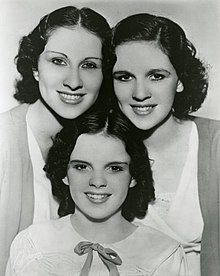The Gumm Sisters
The Gumm Sisters | |
|---|---|
 The Gumm Sisters, also known as the Garland Sisters, c. 1935: Top row: Mary Jane and Dorothy Virginia Gumm; bottom: Judy Garland | |
| Background information | |
| Origin | Lancaster, California, U.S. |
| Genres | Vaudeville |
| Years active | 1924–1935 |
| Members | Judy Garland, Dorothy Virginia Gumm, Mary Jane Gumm |
The Gumm Sisters, later also known as The Garland Sisters[1] were an American vaudeville group consisting of the three daughters of Frank and Ethel Gumm: Judy Garland, Dorothy Virginia Gumm, and Mary Jane Gumm. They gained popularity in the 1920s and 1930s and were known for their harmonious performances and charming stage presence.[2][3][4]
Career
[edit]Early beginnings (1924–1934)
[edit]The Gumm Sisters began their performance career in 1924 under the guidance of their parents, Frank and Ethel Gumm, who were vaudeville performers in Minnesota. The sisters made their stage debut at their father's theater in Grand Rapids, Minnesota, performing various song and dance routines. The Gumm family moved to California, U.S. where the sisters were booked for stage, radio, and movie work by their mother.[5]
Rise to prominence (1934–1935)
[edit]After moving to California, they began performing at various venues, gaining regional attention. They were featured in short films and appeared in significant performances, such as at the 1934 Chicago World’s Fair. During this period, the sisters officially changed their stage name to "The Garland Sisters," at the suggestion of comedian George Jessel, and Frances adopted the stage name "Judy Garland".[6][7]
Transformation and breakthrough of Judy Garland (1935–1936)
[edit]In 1935, Judy Garland was signed to MGM after a standout solo performance that led studio executives to see her potential as a solo act. MGM’s focus on Judy ultimately marked the end of the trio’s career, as the studio prioritized developing her talent individually. The dissolution of the group allowed Judy Garland to rise as a solo star, leading to an illustrious career that would eclipse The Gumm Sisters’ early fame.[citation needed]
Filmography
[edit]| Title | Year | Role | Studio | Type | References |
|---|---|---|---|---|---|
| The Big Revue | 1929 | Performers | Mayfair Pictures | Short film | |
| A Holiday in Storyland | 1929 | Performers | First National Pictures | Short film | |
| The Wedding of Jack and Jill | 1930 | Perfomers | First National Pictures | Short film | |
| Bubbles | 1930 | Perfomers | First National Pictures | Short film | |
| La Fiesta de Santa Barbara | 1935 | Performers | Metro-Goldwyn-Mayer | Short film | [8] |
References
[edit]- ^ Stanton, Scott (2003). The Tombstone Tourist: Musicians. Simon and Schuster. ISBN 978-0-7434-6330-0.
- ^ Finch, Christopher (1975). Rainbow: The Stormy Life of Judy Garland. Grosset & Dunlap. ISBN 978-0448117317.
- ^ Luft, Lorna; Vance, Jeffrey; Movies, Turner Classic (2018-09-18). A Star Is Born: Judy Garland and the Film that Got Away. Running Press. ISBN 978-0-7624-6480-7.
- ^ Fantle, David; Johnson, Tom (2023-10-10). C'mon, Get Happy: The Making of Summer Stock. Univ. Press of Mississippi. ISBN 978-1-4968-4658-7.
- ^ "About | Judy Garland". Judy Garland | Your official home for the latest Judy Garland News.
- ^ "Judy Garland 1922-1934". The Judy Room.
- ^ "Judy Garland". U-S-History.com.
- ^ "Gumm Sisters Shorts". The Judy Room.
